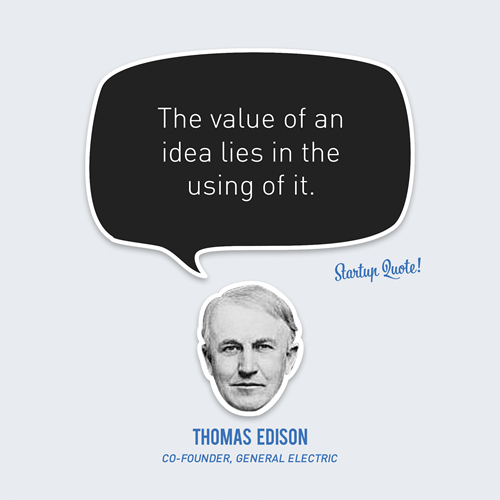 |
| Pic courtesy of Startup Quote (http://startupquote.com/post/11990980073) |
Intellectual Property. You may have heard about it. It’s kind of a big deal if you are an entrepreneur or an inventor. You see it talked about in newspapers, in the context of multi-billion dollar jury awards for infringement. You see it played out in movies like the Social Network, where entire friendships or dreams can be destroyed because of a lack of careful I.P. planning. It has evolved into this kind of nebulous, perhaps intimidating concept that encompasses a huge array of subject matter. A concept that seems so fundamentally easy to understand (i.e. inventions of the mind) yet is accompanied by all these seemingly-conflicting statutes and confusing court opinions.
How do you make sense of it all? How do you determine whether you need I.P. protection?
Start with this concept: I.P. is a core asset. It is as important as the land and machinery that's used to make your products. While I.P. used to be used as an offensive and defensive tool by companies to keep others from encroaching on company rights, today companies are recognizing the need to utilize their I.P. in a completely different light; as a means for promoting innovation, growth and development of businesses ultimately leading to revenue generation. I.P. is seen as a strategic tool that can mirror the goals and mission of a particular business. It therefore stands to reason that no two businesses should have the same I.P. strategy. For example, one business may focus more on developing a particular type of technology and seeking a mix of patent and trade secret protection in one specific country, while another company might go all-in on patents and seek protection in multiple countries.
So, if I.P. is no longer a sword or a shield, how should it be envisioned? Where do you start in the protection process? How do you innovate and publicize your product without it being copied by your competitors? These questions involve dual considerations rooted in legal and business principles. Over the course of the next few weeks, I will be posting short blurbs about intellectual property and how it can be used to add value to your business.
To keep things easy to understand, I will lay out the I.P. lexicon for each type of I.P. protection. Because I.P. overall is actually characterized by different branches, with each branch having a different rationale acting as the foundation for providing protection, it is helpful to use a lock-box analogy. For each type of invention of the mind, there is a separate lock-boxes that can be used to protect the idea:
- Patents protect inventions or discoveries of new and useful processes, machines, articles of manufacture, or compositions of matter. There is also a special class of patents solely devoted to ornamental designs.
- Trademarks are any word, graphic, symbol, sound, color, or even scent that is capable of identifying the source of the trademark. This means that almost anything can be a trademark, so long as it has source identifying capabilities.
- Copyright protection extends to original works of authorship like books, songs, pictures, paintings, even computer code (the underlying source code itself, not the actual processes being performed by instruction from the source code).
- Trade secret protection extends to a formula, practice, process, design, instrument, pattern, or compilation of information which is not generally known and which affords a business an economic advantage over competitors or customers.
So there you have it. What I call the “lock-boxes” of I.P. Each can be used strategically by a business to bring specific advantages either in the form of exclusivity or as an added-value component in the form of licensable rights. But there are nuances associated with each branch of I.P., especially in the way you acquire rights and your ability to enforce the rights against third parties. In the next I.P. post, we will start with an in-depth look at trademarks and how a consumer’s recognition of a particular symbol in the marketplace is legally protected.
 |
| Justin Clark I.P. Attorney The Luther Law Firm, PLC |
Justin is one of desarrollo's community partners and works out of the
Chandler, AZ launchpad a few times a week. He also will be a regular
contributor to the desarrollo 'inspire AZ' Blog.
 |
| Developing Arizona Into The Premiere Place For Entrepreneurs |